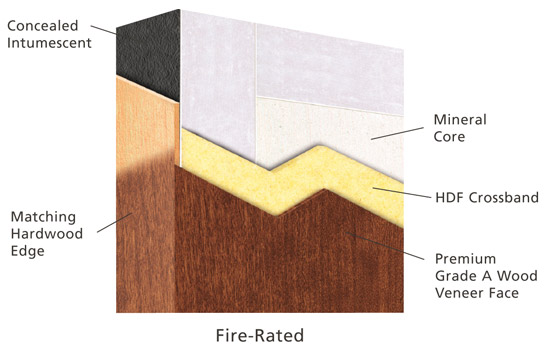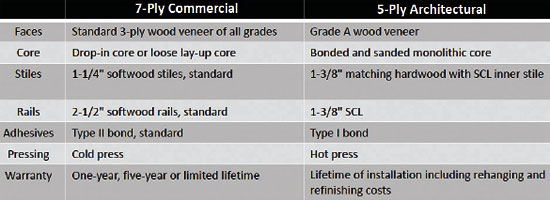What Architects Need to Know About Specifying Wood Doors
Finishing Options
Finishes protect wood from moisture, handling damage and harsh chemicals. Factory finishing provides a consistent finish and reduces on-site VOC (volatile organic compound) emissions. Because they are applied in a controlled, clean, well-lit environment with automated sanding and staining, results are consistent. In contrast, finishes applied in the field are subject to damage and inconsistency due to jobsite conditions, construction dust, poor lighting, and hand sanding and staining. Additionally, responsibility is put on the manufacturer to provide specified color and finish results. WDMA TR-8, UV cured urethane finishes use water based stains. Sealer and top coats are UV (ultraviolet light) cured thus ensuring the product is low-emitting and safe for building occupants.
The precision of the automated factory machining process ensures a seamless installation of a wood door. It also ensures correct performance of the hardware and limits the need for machining on a fire rated door performed by a licensed machiner. Factory machining is commonly available for architectural wood doors, often at no extra cost. Some manufacturers provide value-added options such as factory applied or installed surface applied molding, glazing, louvers, finished top and bottom rails, and sealed rails. These options result in less installation time at the jobsite and ensure desirable design and performance.
Fire Ratings
Fire-rated architectural doors are available from 20- to 90-minutes in positive and neutral pressure to meet building code requirements. Category A positive pressure fire doors have concealed intumescent built into the door. No additional edge-sealing system is required with these doors. Concealed intumescent provides the same seamless elegance as non-rated doors. Architectural doors should always have the approvals and fire labels required for installation in a specific location.
 |
|
Image courtesy of VT Industries, Inc. |
| Typical Specifications |
Specifications vary by grade of door and manufacturer. The table below compares typical architectural specifications for five- and seven-ply doors. The five-ply architectural stile is 1-3/8 inch, composed of hardwood edge with the remainder of the stile being SCL (LSL) for strength, stability, and cost. The advantages of five-ply construction include face material availability, core assembly, and stile and rail performance and aesthetics. Additionally, five-ply doors are most often backed by a lifetime warranty. |
 |
|
Source: VT Industries, Inc. |
Industry Aesthetic Standards
Though WDMA is the industry standard for architectural wood door manufacturers, the Architectural Woodwork Standards (AWS) are typically used in installations where the doors are blueprint matched with wall paneling and/or the adjacent millwork. Veneers are manufactured to exact sizes as the manufacturer determines from the blueprints, clipping and matching each individual face to the project's specific needs. Each face is matched in sequence with adjacent panels, doors, transoms, and cabinet faces as needed to provide continuity.
However, most architectural and commercial doors are not directly associated with panels and millwork. Thus, the requirements in WDMA are more than adequate to assure consistent appearance amongst doors. Specifying a Premium door has a higher cost and availability may be a concern because of the limited supply of AA grade veneer, and center balance match and wider flitch requirements (all three of these requirements make sourcing difficult). Premium grade doors should be reserved for special projects and feature areas. Custom is the standard grade that is intended for high-quality appearance and there is no difference in performance between custom and premium doors.









